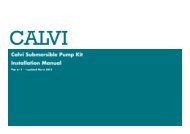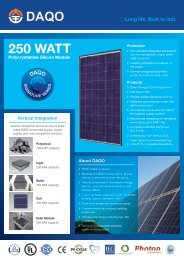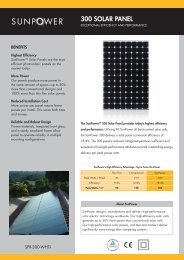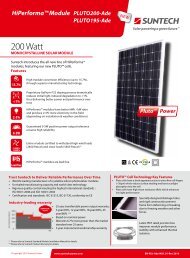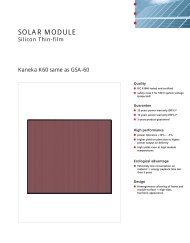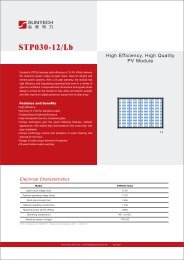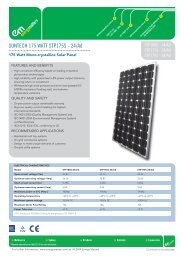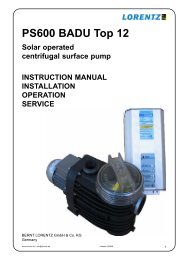Ampair Pacific 300 Wind Turbine Manual - Energy Connect UK
Ampair Pacific 300 Wind Turbine Manual - Energy Connect UK
Ampair Pacific 300 Wind Turbine Manual - Energy Connect UK
You also want an ePaper? Increase the reach of your titles
YUMPU automatically turns print PDFs into web optimized ePapers that Google loves.
<strong>Ampair</strong> <strong>300</strong> <strong>Wind</strong> <strong>Turbine</strong> <strong>Manual</strong>Faulty rectifiers: The rectifiers should last the life of the machine. The most likely cause for their demiseis accidental reverse polarity connection of <strong>Ampair</strong> to battery. If this is suspected the rectifier diode bridgesmust be checked.Diode Test: This test will show if the rectifier diodes are either open or short circuit. If your multimeter hasa diode check feature, select this (if not select the highest resistance range) and, after removing theconnecting wires apply the red meter lead to the red rectifier lead (disconnected from battery plus), blackmeter lead to thick black lead (disconnected from battery minus), and note the reading. Now reverse theconnections.METER LEADPOSITIONRed to Red.Black to RedMULTIMETER SETTINGDIODE TEST OHMS x 100No reading or many Megohms OKReading or low resistance Not OK0.5 to 1 volt (two diode drops) or markedly less* OKNo reading or high resistance Not OKCONCLUSION*This test is not as conclusive as the diode test method however, provided the first reading is a very highresistance and the second reading far lower, then the test is valid. Actual values will depend on thevoltage supplied by the particular meter for its resistance ranges.The rectifiers are located on a separate heat-sink which should have been installed near the regulator.Unsolder the commoning links between the three rectifier outputs to check outputs separately.6.1.1.4 Alternator sectionReferring to the exploded diagram of the wind turbine, undo the six M5 x 50 mm screws on the front of the<strong>Ampair</strong> and pull the front fore-body flange away from the main body. Do this very carefully as it must bewithdrawn true or it will jam on the stator. The shaft and bearings are located using Loctite anaerobicadhesives so some force may be necessary to part them. A puller may have to be improvised to do this.This job should, therefore, be done on a suitable work bench. The rear bearing needs a bearing puller toremove it, if no puller is available, a dummy shaft may be fixed in the bearing centre using epoxy adhesiveand, when cured, the bearing worked loose. The front bearing may be drifted out following removal of thecirclip. Prior to re-assembly, the bearing housings, the bearings inner and outer surfaces and the shaftsurfaces should all be thoroughly cleaned and de-greased.When re-assembling use adhesives as follows:Bearings to body Loctite 641Shaft to bearings Loctite 641When replacing the fore-body, make sure that the new "O" ring is in place and well smeared with siliconegrease. Assemble the body checking that the wiring to the stator cannot touch the rotor. Tighten the sixM5 x 50 mm bolts up slowly and evenly taking care to keep the stator parallel in the housing and tightenuntil the body sealing O ring has been evenly compressed all the way around.6.1.1.5 Stator and rotor replacementThis is normally a factory operation. Rotor damage is unlikely, but sometimes occurs due to corrosion orother mechanical problems. Considerable force is necessary to break the adhesive bond between therotor and rotor shaft and a bearing press with guide tools to protect the shaft is needed. The magnets areboth very powerful and brittle, and so difficult to work with in the field. Rotor/shaft assemblies can bereturned for replacement.Stator failure only normally occurs due to salt water immersion. Any accident causing this necessitates theimmediate cleaning of all parts with fresh water and then drying thoroughly. Leaving to dry naturallycauses the loss of stator winding insulation due to salt corrosion resulting in electrical leakage and shortedturns.- 29 - © <strong>Ampair</strong>, June 2006




